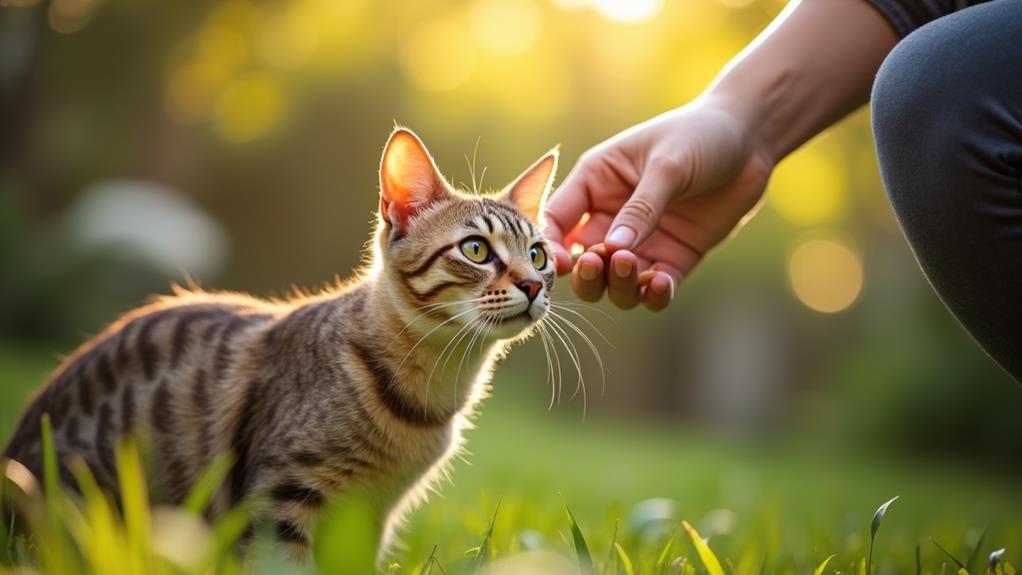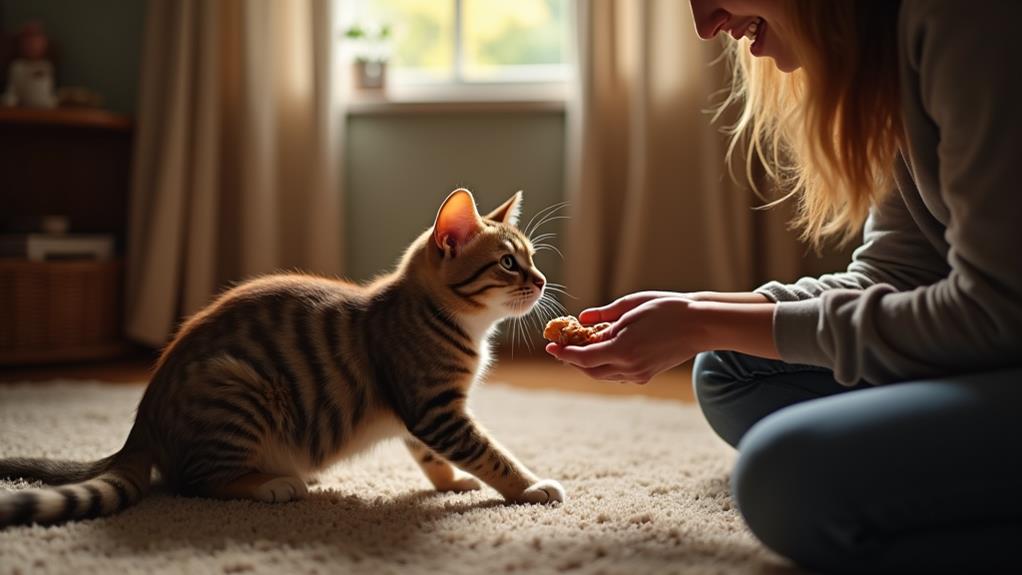How to Bond With a Feral Cat: Building a Relationship Over Time

To bond with a feral cat, start by establishing a consistent feeding routine with strong-smelling foods. Respect their space and maintain a calm demeanor, allowing them to approach you. Provide a safe hiding space, like a weatherproof shelter, to encourage comfort. Use soft voices and gentle movements to reduce anxiety, and gradually introduce play and treats to foster interaction. Pay attention to their body language; slow blinks and closeness are positive signs. Patience and consistency are key as you build trust over time. By understanding these early steps, you're on your way to a strong, trusting relationship.
Understanding Feral Cat Behavior
Understanding the behavior of feral cats requires patience and empathy. Feral cats often exhibit fear of humans and display avoidance behaviors, making them hard to approach. Unlike stray cats, they won't readily seek companionship. To gain their trust, you need to interpret their body language accurately. Look for signals such as flattened ears, dilated pupils, and a crouched posture, which indicate fear or stress. Your goal is to make them feel comfortable around you, which means maintaining a calm demeanor and respecting their space.
Building trust with feral cats involves spending time near them without forcing interaction. Initially, they might only accept food from a distance. Place their food in a safe spot and step back, allowing them to approach without feeling threatened. This process requires patience, as it can take days or even weeks for them to feel secure. Consistently being present without making sudden movements helps them associate you with positive interaction. Over time, as they become more comfortable, they'll start to see you as less of a threat. Remember, the key to bonding with feral cats lies in understanding their needs and moving at their pace.
Establishing a Feeding Routine
Creating a feeding routine is a vital step in building a relationship with a feral cat. By establishing a consistent feeding schedule at the same time each day, you'll help feral cats become familiar with your presence, fostering trust over time. Use strong-smelling cat food, like tuna or wet cat food, to make the feeding more appealing and to attract the cat. It's important to place the food and water in a quiet, safe location where the cat feels secure enough to eat without fear of being approached or startled.
Avoid approaching the community cat while it's eating; instead, maintain a safe distance. This approach allows the cat to associate you with positive experiences, gradually increasing their comfort and trust in your presence. As the cat becomes more accustomed to the routine, you can slowly move the feeding location closer to your home. This gradual change helps the cat associate you with safety and dependability.
Creating a Safe Environment

After establishing a feeding routine, the next step is ensuring that the feral cat feels safe in its environment. Start by providing a safe hiding space. A cozy shelter can make a significant difference. Consider placing a weatherproof outdoor shelter, which offers protection from rain, snow, and extreme temperatures. This creates a safe haven for the cat, reducing stress and helping them feel secure.
Open garage doors or covered porches make excellent temporary refuges. These areas allow the cat to remain close to human activity, gradually getting used to your presence. Regularly placing food and water in consistent locations is essential. This consistency not only reinforces their sense of stability but also encourages them to return regularly.
During feeding times, maintain a non-threatening environment. Use calm voices and gentle movements to help the cat feel more at ease. This approach fosters trust over time, showing the cat they're not in danger around you.
Building Trust Through Patience
Building trust with a feral cat is a gradual process that requires patience and consistency. You need to understand that these cats may have had limited or negative experiences with humans, making them cautious. Patience is key, as it might take days or even weeks for the cat to feel comfortable enough to approach you without fear.
Start by establishing a routine with consistent feeding times. This helps the cat associate your presence with something positive. When you're near the cat, remain calm and still. Avoid sudden movements or direct eye contact, as these can be perceived as threats and cause the feral cat to retreat. Allow the cat to come to you on its own terms. If it sniffs your hand, it's initiating contact, which is a positive step toward trust.
Use soothing vocal tones and move slowly during interactions. This approach helps ease the cat's anxiety and makes it more receptive to getting closer over time. Remember, building trust with feral cats isn't a race; it's about forming a bond at their pace. With patience and understanding, you'll gradually earn their trust and develop a rewarding relationship.
Encouraging Gentle Interaction

Once you've established a foundation of trust with a feral cat, it's time to focus on encouraging gentle interaction. Start by approaching the cat with a fist-shaped hand, which appears less threatening. Let them come to you at their own pace. This non-imposing gesture helps in building trust and making the cat feel comfortable.
Offering treats or wet baby food on a spoon can also encourage proximity. This creates positive experiences, as the cat will begin to associate you with rewards. Remember, the goal is to coax them into interaction without forcing it. Pay attention to their body language; a slow blink or relaxed posture suggests they're comfortable and see you as non-threatening.
Gradually introduce gentle sounds and movements. Soft talking or using toys can create a welcoming environment, but always observe their responses closely. Avoid leaving toys unattended; instead, engage during playtime to strengthen your bond. This active participation shows the cat you're interested in a positive interaction, further encouraging trust.
Using Play to Foster Bonding
Engaging a feral cat in play is a natural way to build trust and strengthen your bond. Start by placing interactive toys, like wand toys, on the floor. This allows the feral cat to approach and engage at its own comfort level without feeling threatened. Over time, gradually introduce simple objects, such as pine cones or rattling mice, to stimulate the cat's natural play instincts. These toys minimize stress from direct interaction, helping to foster the trust of a stray.
During playtime, observe the cat's reactions closely. Adjust your approach based on its comfort, ensuring that movements and sounds remain gentle and non-threatening. This observation is essential for building a relationship over time. Use treats or wet baby food on a spoon as a non-invasive way to encourage proximity. This creates positive associations with playtime and reinforces the bond you're developing.
Recognizing Progress and Challenges

As you work on bonding with a feral cat, recognizing progress and challenges is essential to maintaining momentum. Progress often reveals itself during feeding times when the cat comes closer or observes you with curiosity. These actions indicate growing trust and comfort around you. Celebrate these small milestones as they signify steps toward successful socialization.
However, challenges are inevitable. The cat may show fear or aggression, like hissing or hiding, which can be disheartening. These behaviors mean you need to exercise patience and give the cat more time to adjust. Remember, consistency in your interactions and feeding routine is key. It reassures the cat and helps reinforce positive behavior, gradually building trust.
A significant milestone occurs when the cat initiates contact, perhaps by rubbing against your hand or approaching for treats. This act of courage shows acceptance and a breakthrough in your relationship. But stay mindful of each cat's unique timeline. Socialization varies with individual experiences and personalities, so manage your expectations. By recognizing progress and understanding challenges, you'll better navigate the path, celebrating every step forward, no matter how small.




